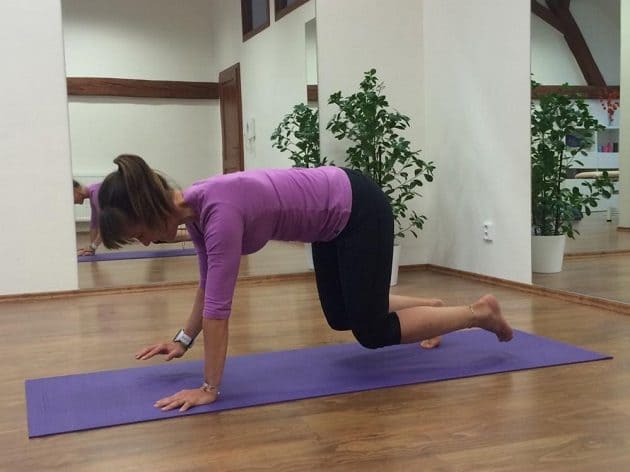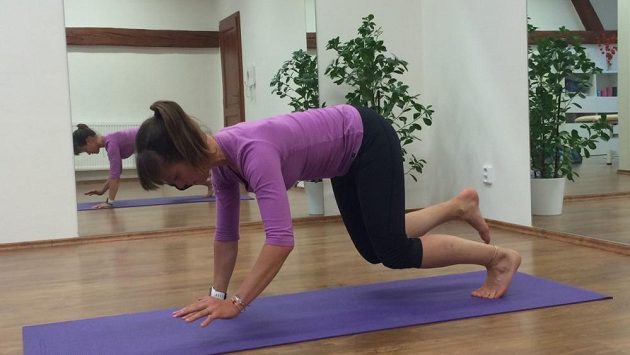Center of the body, core, get to know each other! Can we really engage him?
In all gyms, it offers us lessons focused on the center of the body. Everyone is now aware of the importance of the function of strengthening the center, but few people know what function it really is and an even smaller part of us can engage and use this function.
First of all, it is necessary to say that strengthening the core is not about pulling in the abdomen. If you pull in the abdomen and thus contract the abdominal muscles, you divide the upper and lower half of the body exactly in its center, which at that moment becomes the weakest link of your body. But you wanted to strengthen it, didn’t you?
Try!
Try to tighten your waist with a rubber band for exercise. Tighten the belt so that it grips you. This is how we often contract and feel that we are also strengthening. Now try to lean into the rubber, that is, squeeze it out. In addition, try to breathe into the rubber, this will stretch it a little. You will need to take a breath through the diaphragm and push it like a piston down. Then exhale freely. When you are sure in the first phase, i.e. filling the rubber and inhaling into it, try not to let go of the exhalation, not to let the rubber cut in half, constantly keep your belly actively filled against the pressure of the rubber that wants to chip you. This is the real involvement of the center. Your body center is firm at this moment, but at the same time dynamically flexible. Your spine is well supported from the front by filling – pressurization in the abdomen. Only now the foundation, the frame of movement, is formed. If you start running and keep the center of your body filled in this way, you will run easier, you will not sit in the run, but you will actually run upright. So, this is the first condition of quality involvement of the center, it can be trained anytime, anywhere.
IT WILL COME IN HANDY: Groin pain – Exercises
What muscles make up the Core/center of the body?
Core is not only the muscles of the abdomen, but the interaction of the deep muscles of the abdomen, pelvic floor and especially the diaphragm. The diaphragm is a key muscle here, without the involvement of which strengthening cannot be achieved. The diaphragm works like a piston that compresses the abdominal organs. The diaphragm, which is convex upwards at rest, flattens with a breath and presses perpendicularly down into the organs of the abdominal cavity until it leans against them. If the diaphragm pushes really perpendicularly (the idea of inhaling into the pelvis), the abdomen extends in all directions, not just forward. But the abdominal muscles gradually increase their tension, so the diaphragm can no longer push further down and begins to stretch the lower ribs to the sides. Thus, the pressure of the diaphragm down activates the abdominal muscles, especially the transverse ones, deeply stored. It also activates the deep back muscles. By pushing down, it presses against the pelvic floor, which also engages. With the exhalation, the walls of the fuselage come back a little, but a certain amount of pressurization is still maintained by the diaphragm. The abdomen must definitely not pull in with the exhalation!
When you imagine the hull as a barrel, you can see that all its walls are active and strengthened, but not pulled inward. The barrel is filled and pressurized. And this is precisely the desirable hardening. However, this involvement of the body center brings a number of other benefits. Good involvement of the diaphragm will ensure proper breathing and the use of full lung capacity. In addition, the pressure of the diaphragm down constantly massages the internal organs, and this contributes to their better blood circulation and work.
How to start with Core/Center body exercises?
This interplay of muscles must first be learned in simple static positions. It is ideal to lie on your back with your legs raised or sit down. In a standing position, the center of the body is harder to engage, due to frequent suboptimal adjustment of the pelvis. If the pelvis is tilted a little more forward, which it often is, the diaphragm cannot push perpendicularly into it, but pushes forward, creating pressure in the lumbar spine and there is no symmetrical involvement of all the walls of the trunk.
CORE EXERCISES FOR INSPIRATION
Climbing on fours. Perform kneeling on four like a cat. Check that the wrists are directly under the shoulders and the knees under the hips. Lean on your fingers and remove your knees from the mat. Lighten your arm and leg diagonally. Nothing else will move. Then take a step forward. Then replace your arm and leg and slowly move forward, but the priority is still a straight spine, a motionless torso and filling the center of the body.


Try the following in the car or while sitting at work: Put your hands on your hips, your thumbs back under your ribs, your fingers over your groin, and try to squeeze your fingers out of your belly with your breath. Be careful, it is not a clenching of the muscles under the fingers, but their displacement. Throughout the inhalation, you should feel this filling. The challenge will then be exhalation. The abdomen must not be pulled in. It may drop back a bit, but keep the filling in it. With a breath, fill the belly again.
Gradually, you can increase the difficulty of the exercise. The ideal is then to get to a dynamic movement, but in which you really keep the center of the body.
This series is being prepared for you by Rehabilitation BeBalanced Prague 6 in cooperation with Sport.cz.
Klára Komárková, Dagmar Lisá, Sport.cz
https://www.sport.cz/behani/ladime/clanek/818906-stred-tela-core-seznamte-se-umime-ho-opravdu-zapojit.html#section-artcl
